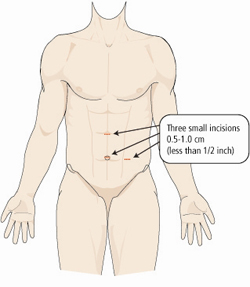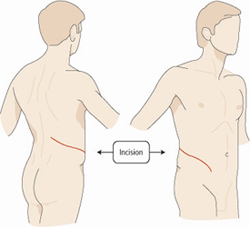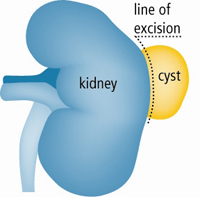Laparoscopic Renal Cyst Decortication
Minimally Invasive Surgery to Remove Kidney Cysts
Simple kidney cysts are common and usually do not cause symptoms. Occasionally, however, they become large and can cause pain or infection. Treatment approaches include needle aspiration of the cysts, laparoscopic cyst decortication and open surgical removal. While needle aspiration is a simple procedure that does not require a hospital stay, cysts recur in at least 50% of cases even with introduction of a sclerotherapy agent.
Both laparoscopic decortication and open surgery offer long-term cure rates of at least 95%. They also are effective methods for determining whether suspicious kidney cysts are benign.
What's more, the laparoscopic procedure is minimally invasive, using 3-4 tiny incisions as opposed to the 1 large flank incision typical of open surgery. Patients have a shorter hospital stay, less postoperative pain, quicker return to full activities and a more favorable cosmetic outcome.

The procedure
Laparoscopic renal cyst decortication is performed through 3-4 1cm incisions in the abdomen (see figure 1a and 1b) or as a single small incision in your belly button, also known as single incision laparoscopic surgery (SILS™ ). A laparoscopic camera inserted through the incisions gives the surgeon a magnified view of the kidney, facilitating careful dissection of the cyst away from surrounding structures. The cyst then is removed using thin, specialized instruments that provide important tactile cues; the surgeon doesn't need to place a hand in the abdomen. (see figure 2) A small temporary drain is placed in the abdomen to drain the kidney area for 1-2 days.
Advantages over open surgery
- Improved visualization of surgical field
- Less pain
- Shorter hospital stay
- Quicker recovery
- Better cosmetic result

Results
Approximately 95% of patients will have complete resolution of the renal cyst, and 90% will have resolution of pain.
Blood loss
There is very little blood loss, and transfusions are extremely rare.
Figure 1b
Traditional open kidney surgery is performed through an 8-12 inch incision extending from the ribs towards the abdomen. A portion of one of the ribs is usually removed as part of the surgery.
Hospital stay
The typical hospital stay is 1-2 days versus 3-5 days for open surgery. Diet Patients resume normal eating as they recover in the first day after surgery or soon thereafter. Postoperative pain Pain is managed immediately with an intravenous patient controlled analgesia pump, which is removed and replaced by pills the day after surgery. Upon discharge, pain pills are given for several days, after which over-the-counter acetaminophen or ibuprofen are usually all that is needed. Urinary catheter A urinary catheter is left in place for 1 day following the surgery.
Diet
Patients resume normal eating as they recover in the first day after surgery or soon thereafter.
Postoperative pain
Pain is managed immediately with an intravenous patient controlled analgesia pump, which is removed and replaced by pills the day after surgery. Upon discharge, pain pills are given for several days, after which over-the-counter acetaminophen or ibuprofen are usually all that is needed.
Urinary catheter
 A urinary catheter is left in place for 1 day following the surgery.
A urinary catheter is left in place for 1 day following the surgery.
Abdominal drain
A small drain placed in the area of the kidney is usually removed the first or second day after surgery.
Recovery
Most patients are able to return to full activity within 3-4 weeks.
Follow-up
Patients follow-up with their surgeon 1 month after the operation, then at 12 and 24 months, with a kidney ultrasound at 1 year to monitor for recurrence. Appointments can easily be conducted over the phone for patients living outside the Boston area, including international patients.
References
1. Atug F, Burgess SV, Ruiz-Deya G, Mendes-Torres F, Castle EP, Thomas R. "Long-term durability of laparoscopic decortication of symptomatic renal cysts." Urology, 2006: 68:272-5
